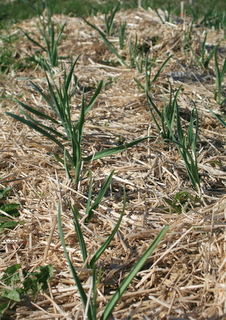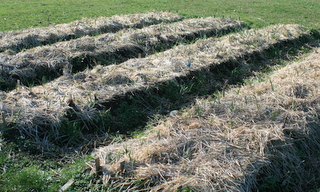 February update here at Barbolian Fields: The garlic is growing strong!
February update here at Barbolian Fields: The garlic is growing strong!
Gosh, it’s great to see those shoots coming up again! I mean, we always know they will, but somehow there is always this little voice that says, “what if they don’t….”
One thing I did differently this year than in previous years is that I put on a heavy layer of straw mulch. Using mulch seems to be the current mantra of good gardening practices, but my response in the past has been, “Well, that depends….”
Yes, mulch keeps in the moisture. In our neck of the woods, it also keeps in the molds – which can be a real problem when it comes to growing garlic in the Pacific Northwest. It also provides a safe haven for critters – voles, earwigs, slugs, to name just a few. Stop the weeds? Not necessarily. In fact, it sometimes encourages weeds and even seeds a few more, depending on the kind of hay or other mulch applied.
So – I was a bit nervous when I started piling on the old hay, which was said to be “as seedless as you’re going to get without paying a hefty price.”
When I planted the garlic last October, it was hard to tell what kind of winter we would get. Around here, we can get a series of damaging freezes and thaws rather than a long freeze that keeps everything dormant. I figured the hay would protect it from these variations. The more I thought about it, the thicker I piled it on. I heaped it on thick.
 As it turned out, we had one of the warmest winters on record. There was a stretch when it did nothing but rain and rain and rain – and the mulch seemed to help filter all that water and prevent erosion of the beds.
As it turned out, we had one of the warmest winters on record. There was a stretch when it did nothing but rain and rain and rain – and the mulch seemed to help filter all that water and prevent erosion of the beds.
I worried that they might compact too much and the garlic wouldn’t come through (that IS what it’s supposed to do to weeds, right?) – but LOOK! There it is! Coming on strong!
It’s going to be a really good year! Stay tuned!
Hello
I just stumbled onto your website here. I like it! Thanks for sharing the information. I too grow garlic down here south of Olympia. I have only around 500 seeds planted in October 2009, and my garlic is looking very good as well. I’m looking to expand my garlic this year, as I have an acre that’s ready to go. All I need is to turn it up, add some rabbit “dung” and then turn it again in Summer… I’m looking to purchase more seed garlic, and have been bouncing around between a guy in Oregon and Filaree for stock.
Of course, we only use all natural fertizilers, etc and never mechanically weed, etc.. All by hand like you.
I’m up your way once or twice a year… I service the hospital up there, and would love to stop by sometime.
Thanks for the site!
Hi Greg! Thanks for the great comment! You are most welcome to stop in at our little farm of sorts when you get up this way. I sold a fair amount of seed garlic last year (not certified organic, but I use organic methods) – but I cut back on almost all the varieties for this year (note that I said “almost” – I planted more of my favorites & also a couple of brand new ones – because sometimes you just can’t help yourself!). You can read more about my dilemma in making that decision on my business blog [update: the blog that the link here connected to was taken down; however, I might do a series of posts on the business of growing garlic in the future.] Now I kind of wish I had doubled the crop instead of cutting back, because I am seeing a much better market for it than I used to, but it would have meant hiring extra help. It’s a sad thing when you grow a lot of garlic and then some of it ends up going to waste! That might not be a problem in the Olympia area. I have purchased a lot of garlic from Filaree over the years and even though it’s a little spendy, I have never been disappointed. Top-quality seed stock every time, very clean, no molds, viruses, or questionable spots. What I find, though, is that our climates are different. I used to live in the Okanogan area, and they typically have cold winters, lots of snow, and very hot summers. It takes awhile for the garlic to acclimatize to our conditions. Some varieties adapt more easily than others. When you can, go local!